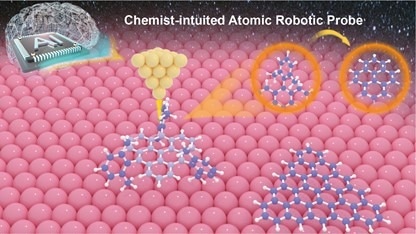Reviewed by Lexie CornerMar 4 2024
Researchers at the National University of Singapore (NUS) have developed an innovative approach to creating carbon-based quantum materials on a molecular level by combining scanning probe microscopy methods with advanced neural networks.
 Figure illustrates the chemist-intuited atomic robotic probe that would allow chemists to precisely fabricate organic quantum materials at the single-molecule level. The robotic probe can conduct real-time autonomous single-molecule reactions with chemical bond selectivity, demonstrating the fabrication of quantum materials with a high level of control. Image Credit: Nature Synthesis
Figure illustrates the chemist-intuited atomic robotic probe that would allow chemists to precisely fabricate organic quantum materials at the single-molecule level. The robotic probe can conduct real-time autonomous single-molecule reactions with chemical bond selectivity, demonstrating the fabrication of quantum materials with a high level of control. Image Credit: Nature Synthesis
This advancement underscores the possibilities of utilizing artificial intelligence (AI) on a minuscule scale to improve precision in atomic production, offering advantages for basic scientific studies and future technological uses.
Open-shell magnetic nanographenes are an attractive group of novel carbon-based quantum materials that contain strong π-spin centers and complex collective quantum magnetism. These characteristics are essential for advancing high-speed electronic devices on a molecular scale and creating quantum bits, which are the fundamental components of quantum computers.
Despite the progress in the synthesis of these materials using on-surface synthesis (a solid-phase chemical reaction method), achieving accurate fabrication and customization of the properties of these quantum materials at the atomic level continues to be a challenging task.
Associate Professor Jiong Lu from the Department of Chemistry and the Institute for Functional Intelligent Materials and Associate Professor Chun Zhang from the Departments of Physics and Chemistry at NUS have pioneered the chemist-intuited atomic robotic probe (CARP). By combining probe chemistry knowledge and AI, they have successfully manufactured and analyzed open-shell magnetic nanographenes at the individual molecule level.
This groundbreaking approach enables the precise manipulation of their π-electron topology and spin configurations through automated processes, resembling the expertise of human chemists.
The utilization of deep neural networks in the CARP concept enables the autonomous synthesis of open-shell magnetic nanographene by leveraging the expertise and experience of surface science chemists.
It can also extract chemical information from the experimental training database, providing insights into unknown mechanisms. This collaboration, led by Associate Professor Xiaonan Wang from Tsinghua University in China, serves as a crucial complement to theoretical simulations, enhancing our overall comprehension of probe chemistry reaction mechanisms.
The research findings are published in the journal Nature Synthesis.
The scientists conducted experiments on the CARP concept in a complex site-selective cyclodehydrogenation reaction aimed at synthesizing chemical compounds with distinct structural and electronic features.
Findings indicate that the CARP framework effectively integrates the researcher's expertise and translates it into machine-readable instructions, replicating the process to carry out individual molecule reactions that can control the shape and spin properties of the resulting chemical compound.
The research team is also striving to fully utilize the capabilities of AI by uncovering concealed insights from the database. They have implemented an intelligent learning model that employs a game theory-based methodology to evaluate the framework’s learning achievements.
The findings indicate that CARP has effectively captured crucial intricacies that may elude human observation, particularly in achieving successful cyclodehydrogenation reactions. This implies that the CARP framework holds significant potential as a valuable resource for further understanding the mechanisms behind unexplored single-molecule reactions.
Our main goal is to work at the atomic level to create, study, and control these quantum materials. We are striving to revolutionize the production of these materials on surfaces to enable more control over their outcomes, right down to the level of individual atoms and bonds.
Jiong Lu, Associate Professor, Department of Chemistry and the Institute for Functional Intelligent Materials, National University of Singapore
Lu added, “Our goal in the near future is to extend the CARP framework further to adopt versatile on-surface probe chemistry reactions with scale and efficiency. This has the potential to transform conventional laboratory-based on-surface synthesis processes towards on-chip fabrication for practical applications. Such transformation could play a pivotal role in accelerating the fundamental research of quantum materials and usher in a new era of intelligent atomic fabrication.”
Journal Reference:
Su, J., et al., (2024) Intelligent synthesis of magnetic nanographenes via chemist-intuited atomic robotic probe. Nature Synthesis. doi:10.1038/s44160-024-00488-7.